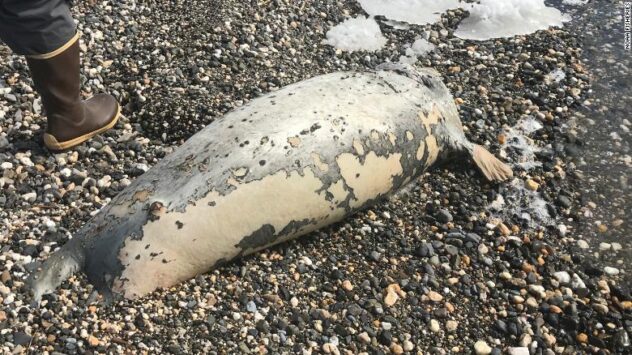
A dead seal found on a beach near Kotzebue, Alaska
©Raime Fronstin/NPS/NOAA Fisheries
Vocabulary:
I will read the words, meanings, and sample sentences. Then, repeat after me.
- jeopardy /JEP-er-dee/
- repercussion /ree-per-KUHSH-uhn/
- hazardous /HAZ-er-duhs/
- security /si-KYOOR-i-tee/
- coincide /koh-in-SAHYD/
[noun] – danger of loss, harm, or failure
Thousands of jobs are in jeopardy due to the ongoing health crisis.
[noun] – an unintended consequence occurring some time after an event or action, especially an unwelcome one
Margaret’s resignation will have serious repercussions on the firm.
[adjective] – dangerous
The new environmental regulations aim to reduce hazardous air pollutants.
[noun] – the fact that something is not likely to fail or be lost
Teachers went on strike last week to demand job security.
[verb] – to happen at or near the same time
Personal and national interests seem to coincide between the government officials.
Article reading:
Please read the whole article. Then, I will check your pronunciation and intonation.
The ice in Alaska isn’t simply melting; it’s gotten to the point where some residents’ food and jobs are in jeopardy. Satellite data suggests that ocean temperatures in the Chukchi and North Bering seas are over 10 degrees Fahrenheit (five degrees Celsius) above normal. University of Alaska climate specialist Rick Thoman noted that there are immediate local and commercial repercussions along the state’s western and northern beaches. “The seas are extraordinarily warm. It is impacting the ability for Americans in the region to put food on the table right now.” Sea temperatures are warm enough to support algal blooms, which can make the waters hazardous to species, and birds and marine animals are turning up dead. “The northern Bering & southern Chukchi Seas are baking,” Thoman wrote on Twitter.
Several coastal Alaska towns that rely on fishing to support their economies and feed their residents are facing a growing issue. “Much of what the people eat there over the course of the year comes from food they harvest themselves,” said Brian Brettschneider, a climatologist at the International Arctic Research Center. “If people can’t get out on the ice to hunt seals or whales, that affects their food security. It is a human crisis of survivability.” Scientists warn that occurrences like this, in which weather patterns coincide to produce dramatic consequences, are proof of an escalating global dilemma.
Several coastal Alaska towns that rely on fishing to support their economies and feed their residents are facing a growing issue. “Much of what the people eat there over the course of the year comes from food they harvest themselves,” said Brian Brettschneider, a climatologist at the International Arctic Research Center. “If people can’t get out on the ice to hunt seals or whales, that affects their food security. It is a human crisis of survivability.” Scientists warn that occurrences like this, in which weather patterns coincide to produce dramatic consequences, are proof of an escalating global dilemma.
Discussion Questions:
I will read each question. Then, please answer them.
- Has climate change affected the country in which you live? Please tell me more about it.
- What is your country doing to limit the effects of climate change?
- How would you explain climate change to someone who knows nothing about it?
- Is climate change the worst thing ever to happen to humankind?
- Which industries do you think need to become cleaner and greener?
Summarization
Please summarize the whole article using your own words and expressions. You will have one minute to prepare before you answer.
Describe:
Please explain the definition of each word listed below based on your understanding. You can provide example sentences if needed.
- above normal
- species
- marine
- fishing
- survivability